APPENDIX B THE KLM MODEL IN THIS APPENDIX THE
3 APPENDIX 1 DEVELOPING A SAFER3 APPENDIX 1 SAFER CARING PLAN
3 APPENDIX 1 SAFER CARING POLICY
APPENDIX 1 SAFE USE OF BED RAILS
APPENDIX 19 STANDARD BOARD OF EXAMINERS AGENDA
APPENDIX E GUIDELINES FOR MANAGERS DEALING WITH ALCOHOL
APPENDIX A
APPENDIX B:
THE KLM MODEL
In this appendix, the KLM model as originally proposed by Krimholtz et al. [1970] is analyzed. First, an expression for the electrical input impedance of the KLM model will be derived based on the model parameters. Then, the pressure radiated by the KLM model as a function of applied voltage in the phasor domain will be determined. Finally, some related MATLAB functions are provided at the end of the appendix.
Input Impedance of the KLM Model
The KLM model for the piezoelectric transducer is provided in Figure B.1 [Krimholtz et al., 1970].
Figure B.1: The KLM model of the piezoelectric transducer.
In this model, V3 and I3 are the
respective voltage and current applied to the piezoelectric crystal
which produce the resulting acoustic forces F and particle
velocities U at the respective faces of the crystal. The
particle velocities inside of the crystal are denoted by
![]() where the F subscript indicates forward traveling waves
propagating towards interface 2, the B subscript indicates
backward-traveling waves propagating towards interface 1, and the
denote waves in the right and left half of the crystal respectively.
where the F subscript indicates forward traveling waves
propagating towards interface 2, the B subscript indicates
backward-traveling waves propagating towards interface 1, and the
denote waves in the right and left half of the crystal respectively.
The model parameters include the thickness of the crystal d, the area of the crystal A, and the characteristic impedance of the acoustic transmission line (i.e., the radiation impedance) modeling the piezoelectric crystal Zo. The impedances Z1 and Z2 are the respective radiation impedances of the medium into which the crystal is radiating. A detailed discussion of acoustical impedances can be found in [Kinsler et al., 2000]. In order to complete the model, it is also necessary to include a capacitor Co, impedance jX1, and a transformer with the ratio (1:) that converts the electrical signal into the appropriate acoustical values. Co results from the resonator consisting of a dielectric, the piezoelectric crystal, between two excited conducting surfaces. The values for these parameters as given by [Krimholtz et al., 1970] are
 (B.1)
(B.1)
where is the permittivity of the piezoelectric under no applied voltage, h is the piezoelectric pressure constant for the crystal, is the density, and c is the speed of longitudinal sound waves in the crystal.
Now that the model is in place, we can determine the input impedance of the piezoelectric transducer in terms of the model parameters. The impedance seen looking into port 3 is given by
![]() (B.2)
(B.2)
where Za is the impedance seen looking into the acoustic transmission line given by [Pozar, 1998]
![]() (B.3)
(B.3)
where
 (B.4)
(B.4)
Therefore, the total input impedance for the KLM model can be found by evaluating Equations (B.2)-(B.4).
Often a complete expression for the input impedance is not necessary,
and one is only interested in obtaining an approximate expression
valid near the fundamental resonant frequency for the transducer that
occurs when
![]() .
As a result, the model parameters at frequencies near o
can be approximated as
.
As a result, the model parameters at frequencies near o
can be approximated as
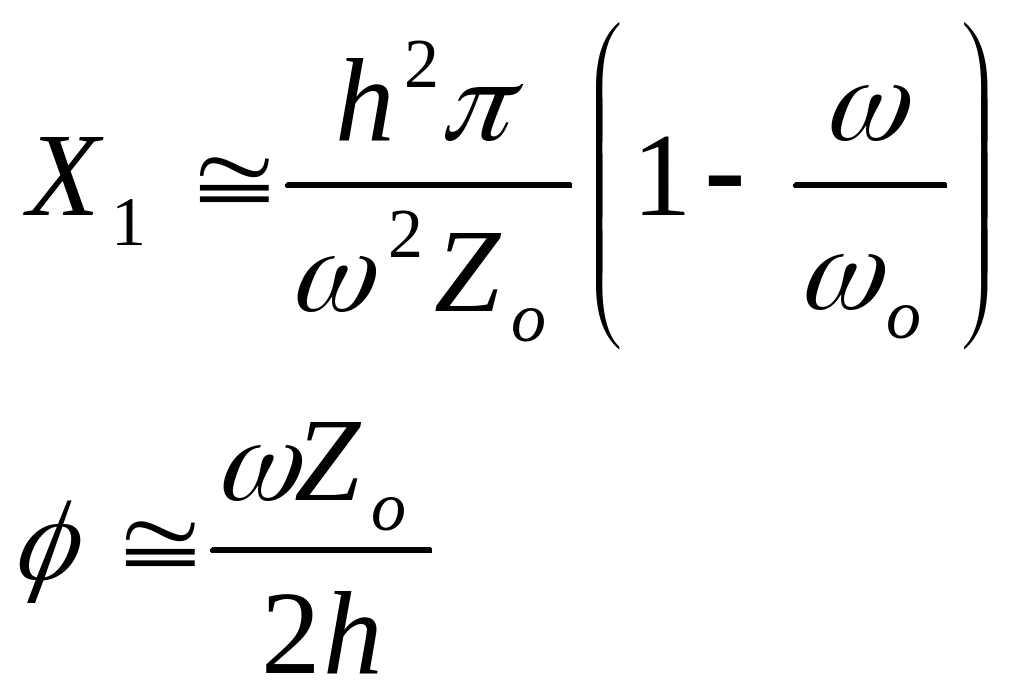 (B.5)
(B.5)
Furthermore, near resonance, the impedance seen looking into the acoustical transmission line, ZL1 and ZL2, reduce to
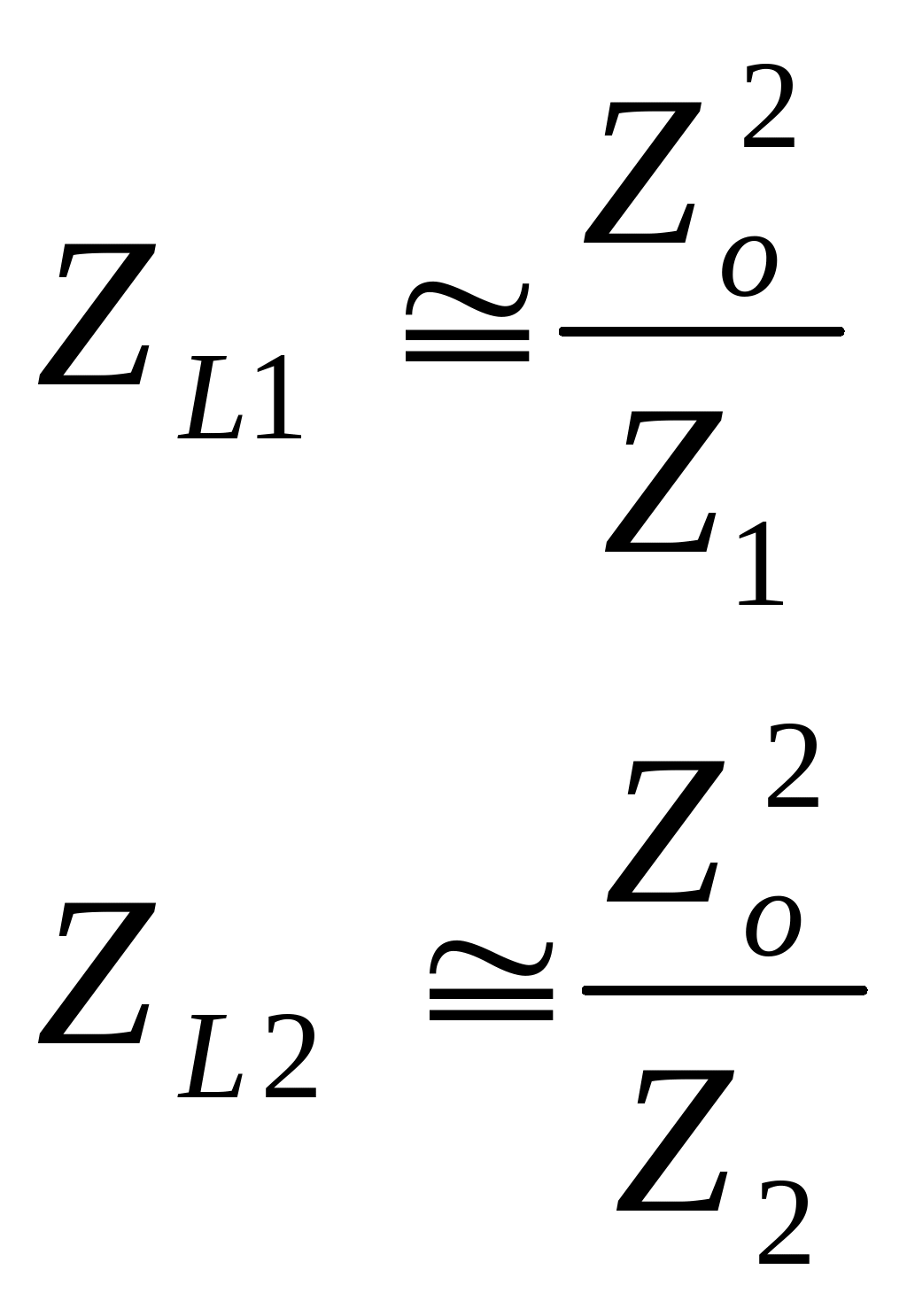 (B.6)
(B.6)
resulting in a Za of
![]() (B.7)
(B.7)
Therefore the input impedance of the KLM model near resonance is given by
 (B.8)
(B.8)
Before leaving our discussion of the input impedance for the KLM model, it is important to point out that (B.8) was derived assuming that neither Z1 nor Z2 were zero (i.e., free space). Therefore, (B.8) cannot be applied to certain piezoelectric transducer configurations.
Radiated Pressure based on the KLM Model
In the previous section, we derived expressions for the input
impedance of the piezoelectric transducer based on the KLM model. In
this section, we will continue the analysis to determine the pressure
radiated by the transducer when it is excited by a voltage in the
phasor domain (i.e.
![]() ).
The analysis will be done by summing the particle velocities at the
center of the acoustical transmission line. Recall that particle
velocities in the acoustical transmission line are analogous to
currents in an electrical transmission line. A detailed discussion
of transmission line theory is proved by Pozar in [1998].
Summing the velocities yields
).
The analysis will be done by summing the particle velocities at the
center of the acoustical transmission line. Recall that particle
velocities in the acoustical transmission line are analogous to
currents in an electrical transmission line. A detailed discussion
of transmission line theory is proved by Pozar in [1998].
Summing the velocities yields
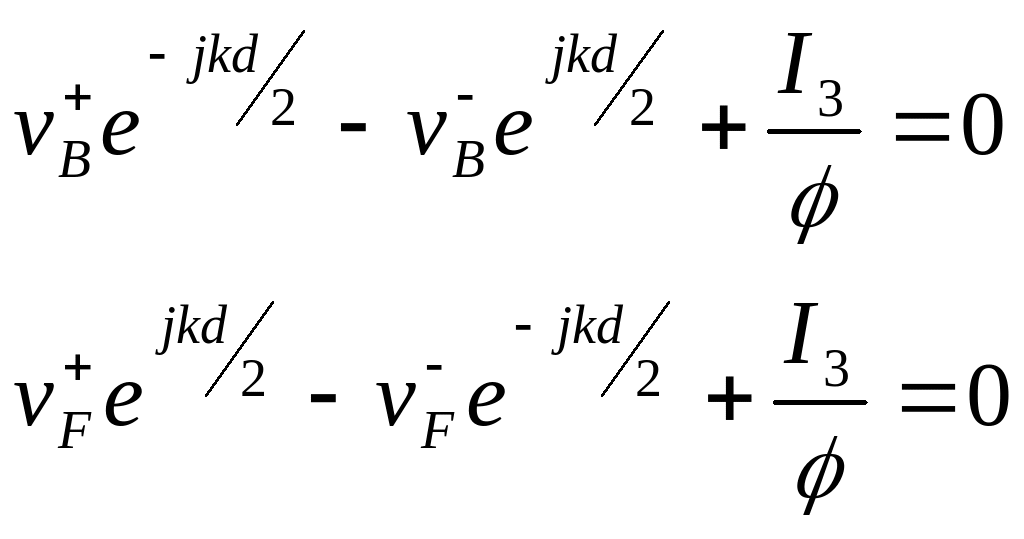 (B.9)
(B.9)
where k is the wave number in the crystal. However, from transmission line theory, we know that
![]() (B.10)
(B.10)
where 1 and 2 are the current transmission coefficients given by
 (B.11)
(B.11)
Substituting Equations (B.10) and (B.11) back into Equation (B.9) and solving the resulting matrix equation yields
 (B.12)
(B.12)
Transmission line theory can then be used to solve for U1 and U2 yielding
 (B.13)
(B.13)
Finally, replacing I3 by V3 and solving for the pressure wave leaving the surface of the piezoelectric crystal yields,
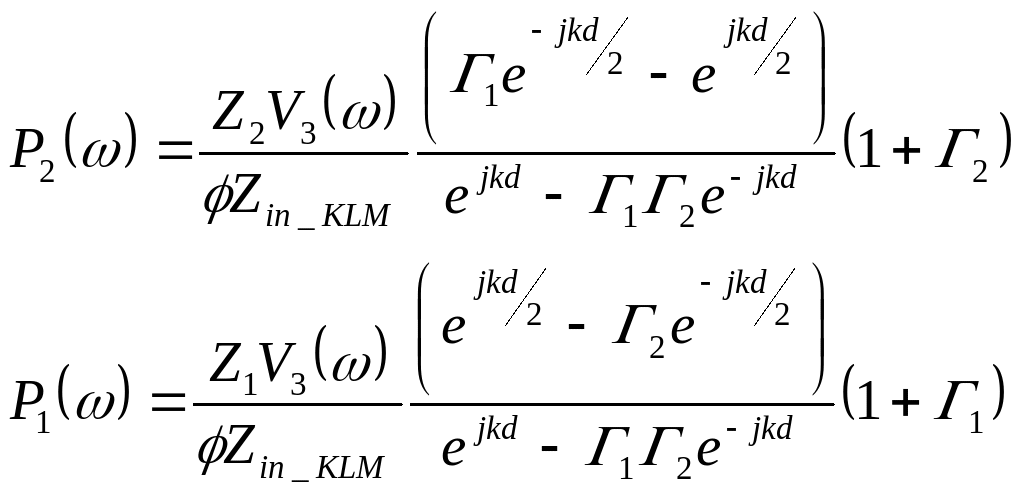 (B.14)
(B.14)
Equation (B.14) can also be used to determine the pressure radiated by a piezoelectric crystal excited by a transient voltage pulse by decomposing the pulse into the respective frequency components, determining the pressure radiated for each component in the Fourier domain, and then using the inverse Fourier transform to assemble the resulting pressure pulse.
APPENDIX H SURROGATE CONSENT PROCESS ADDENDUM THE
LOCAL ENTERPRISE OFFICE CAVAN MENTORING PANEL APPENDIX
(APPENDIX) INSTRUCTIONS FOR FOREIGN EXCHANGE SETTLEMENTS OF ACCUMULATED NT
Tags: appendix b:, appendix, model
- Discoverer Manual for Financial Managers 1 log Into the
- REGULAMIN NADAWANIA KLAS SPORTOWYCH ZAWODNIKOM I ZAWODNICZKOM UCZESTNICZĄCYM W
- CHAPTER 6B AN INTRODUCTION TO HTML (PAGES 169180) TAG
- DR HAB PROF UJ ANNA CZABANOWSKAWRÓBEL LITERATURA DLA DZIECI
- POWERPLUSWATERMARKOBJECT3 NADCAP MANAGEMENT COUNCIL MARCH 2011 UNCONFIRMED MINUTES MARCH
- FORMPENDAFTARAN PPS IKIP PGRI JEMBER PRODI PILIHAN TEKNOLOGI
- Saludo en China se Realiza Inclinando Levemente el Cuerpo
- 4 AUTHORITIES ON THE MEANING INVOLVES A QUESTION OF
- THE OPEN UNIVERSITY OF ISRAEL DEPARTMENT OF MATHEMATICS AND
- S EP I NSTITUTO TECNOLÓGICO SUPERIOR DE ZACAPOAXTLA ORGANISMO
- FORMULIR PERMOHONAN PERSETUJUAN KOMITMEN KEPADA YTH BAPAK SUKAMARA
- 84 MO DERNE MÜNZEN MÜNZEN BANKNOTEN
- C ATEGORÍA 4 RELACIONES CON LA PRENSA MARCA UNILEVER
- MAJOR METROPOLITANPOPULATION CENTERS FOR POTENTIAL MAJOR MEDIA STATE MAJOR
- MODELO DE CONTRATO DE CONSTITUCIÓN DE UN FONDO DE
- COMUNICADO DE PRENSA 27 DE NOVIEMBRE DE 2006 LANZA
- NA TEMELJU ČLANKA 39 STATUTA GRADA VIROVITICE („SLUŽBENI VJESNIK
- RADICACIÓN 73001310300420110008101 CONTRATO DE AGENCIA COMERCIALPROMOCIÓN Y VENTA DEL
- GOODE CONSUMER CREDIT LAW AND PRACTICE PROFESSOR SIR
- NP 158 GABINETE DE PRENSA 24 DE FEBRERO DE
- the Metacognitive Student—study Guide the Metacognitive Student how to
- COMISIÓN CON POTESTAD LEGISLATIVA PLENA SEGUNDA 4
- DDª CON DNI NÚM (EN ADELANTE EL “PONENTE”) MEDIANTE
- TAREA SEMANAL DEL 11 AL 15 DE MAYO ALUMNOA
- ŚRODKI DYDAKTYCZNE1 (F SZLOSEK) 1 E GOŹLIŃSKA SŁOWNICZEK NOWYCH
- MODELU KARTONÓWEK MOŻNA BUDOWAĆ WG WŁASNYCH PROJEKTÓW PAMIĘTAJĄC O
- UNOFFICIAL NOMINATION FORM FOR PROJECT 201010 — FAC STANDARDS
- STATUT ZESPOŁU SZKOLNOPRZEDSZKOLNEGO W KLUCZEWIE ROZDZIAŁ 1 PRZEPISY OGÓLNE
- APPROVED BY BOARD OF DIRECTORS MOULTON NIGUEL WATER DISTRICT
- STUDENT WORKBOOK SECTION 1 INTRODUCTION DESCRIPTIVE STATISTICS
SUPREMEI COURT OF QUEENSLAND REGISTRY NUMBER PLAINTIFF2 (AS PER
 DECLARACIÓN ANUAL DE VERTIDOS URBANOS AÑO OBSERVACIONES GENERALES PARA
DECLARACIÓN ANUAL DE VERTIDOS URBANOS AÑO OBSERVACIONES GENERALES PARAPOPELU GUIÓN NARRADOR EN EL PUEBLO DE LOS DUENDECILLOS
POLICY WORK UNDERTAKEN THE LAST 12 MONTHS VICTORIAN ABORIGINAL
ATLANTEN – SVØM 2006 MED NSF’S GODKJENNING IFØLGE TERMINLISTA
 REPUBLIKA HRVATSKA ŽUPANIJSKI SUD U ZAGREBU URED PREDSJEDNIKA SUDA
REPUBLIKA HRVATSKA ŽUPANIJSKI SUD U ZAGREBU URED PREDSJEDNIKA SUDA REPUBLIKA HRVATSKA ŠIBENSKOKNINSKA ŽUPANIJA OPĆINA TISNO NAČELNIK 22240 TISNO
REPUBLIKA HRVATSKA ŠIBENSKOKNINSKA ŽUPANIJA OPĆINA TISNO NAČELNIK 22240 TISNO PROVIDER DISPUTE RESOLUTION REQUEST NOTE SUBMISSION OF THIS FORM
PROVIDER DISPUTE RESOLUTION REQUEST NOTE SUBMISSION OF THIS FORMQU’APPRENDON EN FRANÇAIS ET EN HISTOIREGÉOGRAPHIE AU LYCÉE PROFESSIONNEL
AER STAKEHOLDER ENGAGEMENT FRAMEWORK ISBN 978 1 921973 91
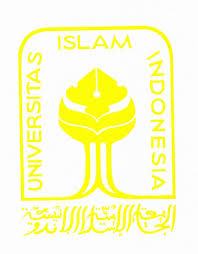 JUDICIAL PREVIEW SEBAGAI MEKANISME VERIFIKASI KONSTITUSIONALITAS HASIL RATIFIKASI PERJANJIAN
JUDICIAL PREVIEW SEBAGAI MEKANISME VERIFIKASI KONSTITUSIONALITAS HASIL RATIFIKASI PERJANJIANCASE NO 2011DPWK410833 DISTRICT OF COLUMBIA OFFICE OF ADMINISTRATIVE
CURRÍCULUM VITAE ORIOL LÓPEZ MAYOLAS DATA DE NAIXEMENT 20
 COMPARTIMENT ACHIZIȚII PUBLICE CONTRACT DE FURNIZARE NR DIN
COMPARTIMENT ACHIZIȚII PUBLICE CONTRACT DE FURNIZARE NR DIN!DOCTYPE HTML HTML LANGEN CLASSPBPAGE DATAREQUESTIDDB0AD7B179F94CE099D7E6A997900D3A HEAD DATAPBDROPZONEHEADMETA NAMEPBCONTEXT
APUNTES Y COMENTARIOS SOBRE LA AUDIOVISIÓN DE MICHEL CHION
MAPPING FORMAT SUBJECT UNIT DAYSWEEKS STANDARDS RESOURCES
 Anexo V Modelo DE Encomienda DE Gestión Entre
Anexo V Modelo DE Encomienda DE Gestión EntreORDEN DE 3 DE ABRIL DE 1998 POR LA
 ÇANKAYA ÜNİVERSİTESİ ÖĞRENCİ SAĞLIK İŞLERİ VE SAĞLIK RAPORLARI YÖNERGESİ
ÇANKAYA ÜNİVERSİTESİ ÖĞRENCİ SAĞLIK İŞLERİ VE SAĞLIK RAPORLARI YÖNERGESİ
